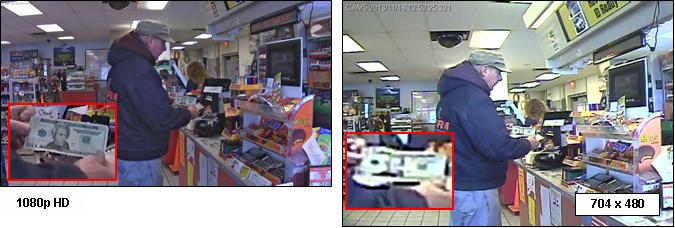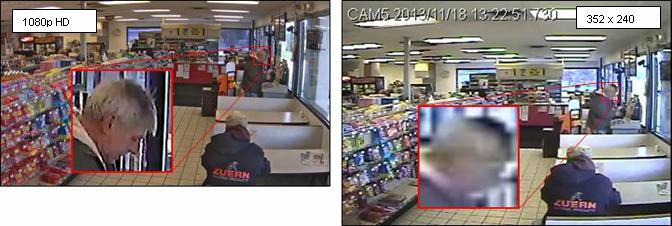Cameras - HD
HD (acronym short for High Definition) is the latest in a variety of video camera technologies (HD-CVI, HD-AHD, HD-SDI, HD-TVI, etc.) that provide better than analog camera resolution while still transmitting their video signal over coaxial cable.
As we've noted previously, there are many features that define even the simplest video cameras but the single most important aspect is resolution. To illustrate this key point we conducted a simple, real-world experiment at an actual GSS customer site.
We built a mobile camera mounting stand which we affixed to the top of an 8-foot step ladder. On once side we mounted the best analog camera we've evaluated and on the other side an HD camera. Each camera was "set up" with as identical field of view as possible and each was simultaneously recorded on the same hybrid recorder – the analog at 4CIF (704 x 480) and the HD at 1080p (1920 x 1080)
Finally, for presentation purposes, each still image (excerpted from the recorded video) has been re-sized to the same horizontal width – so together, they both fit side by side on the page.
CASE #1 (below)
As we've noted previously, there are many features that define even the simplest video cameras but the single most important aspect is resolution. To illustrate this key point we conducted a simple, real-world experiment at an actual GSS customer site.
We built a mobile camera mounting stand which we affixed to the top of an 8-foot step ladder. On once side we mounted the best analog camera we've evaluated and on the other side an HD camera. Each camera was "set up" with as identical field of view as possible and each was simultaneously recorded on the same hybrid recorder – the analog at 4CIF (704 x 480) and the HD at 1080p (1920 x 1080)
Finally, for presentation purposes, each still image (excerpted from the recorded video) has been re-sized to the same horizontal width – so together, they both fit side by side on the page.
CASE #1 (below)
NOTE – The HD image has enough resolution that the vehicle in the background can be “zoomed in on” to read the lettering on the side of the van while the 4CIF image on the right doesn’t have enough definition to even identify that there might be lettering.
CASE #2 (below)
CASE #2 (below)
Now these images (above) very well depict four (4) pump lanes of this convenience store’s pump line and both are examples of extremely clean video. The analog image (right) simply lacks the pixel density for any reasonable post recording analysis of the subject(s) – Note, when magnified to the exact same size, the HD image (left), the critical information on the vehicle plate is easily discernible.
NOTE: In this example the camera is ~50 feet from the vehicle.
CASE #3 (below)
NOTE: In this example the camera is ~50 feet from the vehicle.
CASE #3 (below)
Similar to the post-recording license plate identification above, these two frames detail how the HD image is able to discern the $20.00 bill while the very clear 4CIF image lacks the resolution to provide any level of accurate post recording detail.
Finally, while the previous examples have all shown 4CIF, nearly the highest analog resolution recording possible, this last pairing compares HD (left) vs. 1CIF (right) and is a dramatic demonstration of why you – as a business owner – might want to step up to High Definition video security.
1CIF is equivalent to most installed video security systems today!
CASE #4 (below)
Finally, while the previous examples have all shown 4CIF, nearly the highest analog resolution recording possible, this last pairing compares HD (left) vs. 1CIF (right) and is a dramatic demonstration of why you – as a business owner – might want to step up to High Definition video security.
1CIF is equivalent to most installed video security systems today!
CASE #4 (below)
The image right (even though it is only recorded at 352 x 240, 1CIF) is certainly, by most critics’ standards, a very good image. The lettering on the back of the gentleman’s blue coat (lower right) is clearly legible and it is easy to see the second subject – the man in front of the ATM machine.
The post-recording zoom of the CIF image is blurred and unrecognizable while that from the HD camera (left) is crisp, clean and very likely, easily identifiable by someone who knows the gent.
If (for whatever reason) you REALLY NEEDED TO IDENTIFY the gentleman at the ATM, which of these two images would you want recorded on your system?
Concluding this subject, if you have invested any time on this site to date you well understand our commitment to VALUE. Time will determine if HD technology has a future. While we've installed a few HD systems as well as a few hybrid systems that have included some HD cameras, GSS has chosen to focus on delivering GREATER VALUE by implementing only IP cameras on all future installations.
The post-recording zoom of the CIF image is blurred and unrecognizable while that from the HD camera (left) is crisp, clean and very likely, easily identifiable by someone who knows the gent.
If (for whatever reason) you REALLY NEEDED TO IDENTIFY the gentleman at the ATM, which of these two images would you want recorded on your system?
Concluding this subject, if you have invested any time on this site to date you well understand our commitment to VALUE. Time will determine if HD technology has a future. While we've installed a few HD systems as well as a few hybrid systems that have included some HD cameras, GSS has chosen to focus on delivering GREATER VALUE by implementing only IP cameras on all future installations.




